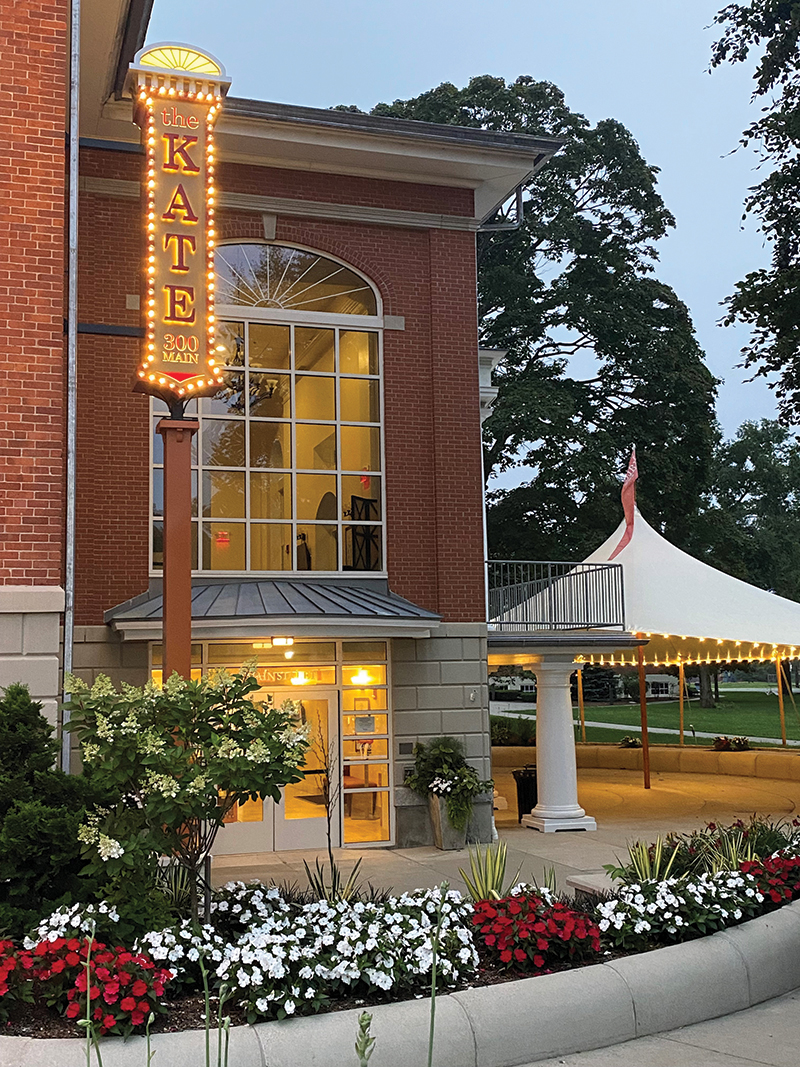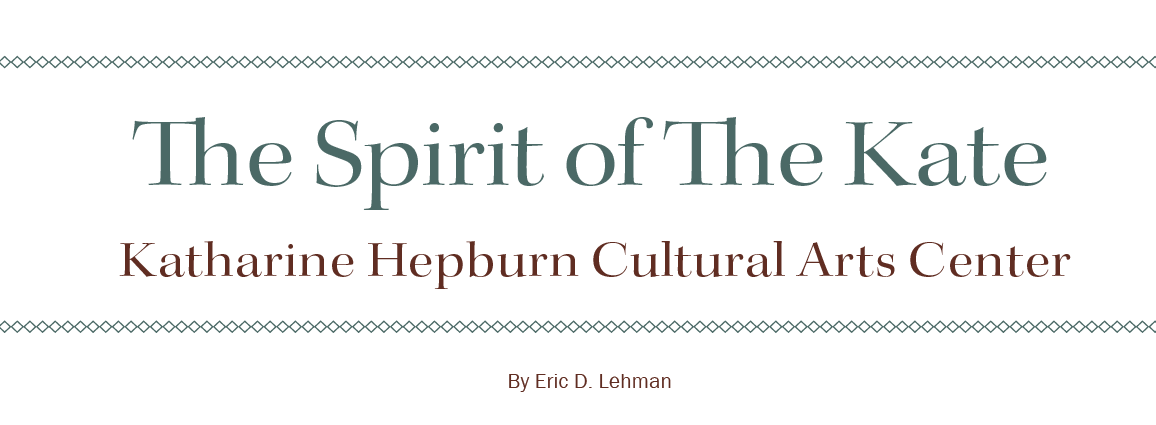
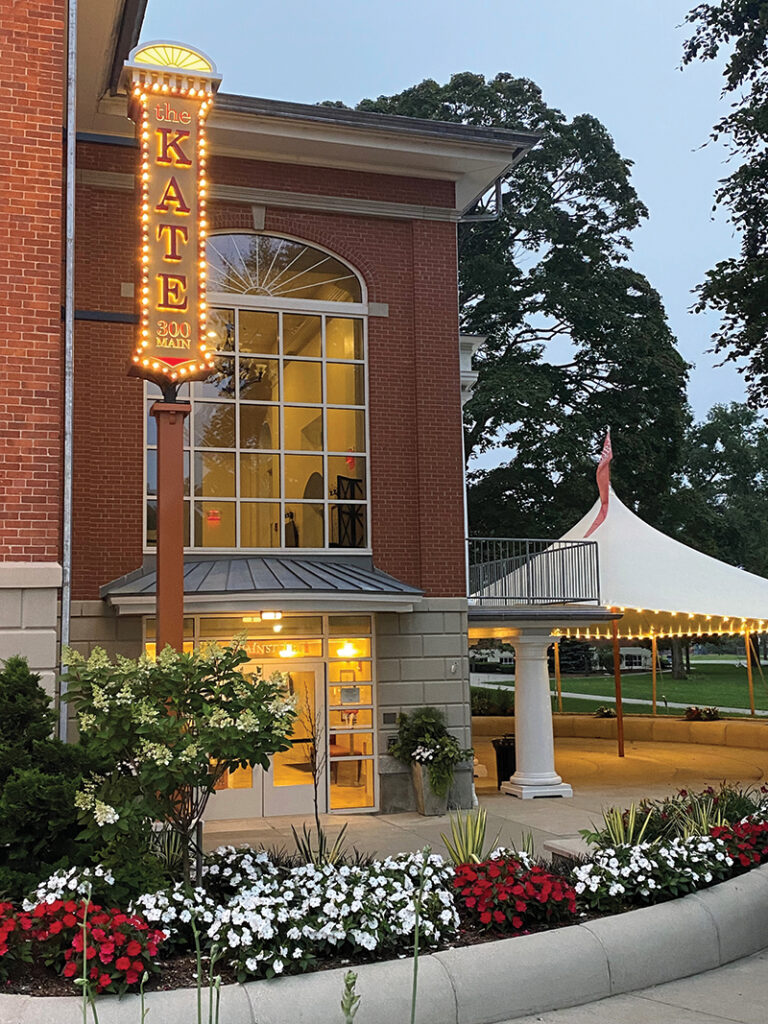
The Kate.
Image Credit: Brett Elliott.
On a foggy Wednesday evening, people begin to gather on the wide boulevard outside the Katharine Hepburn Cultural Arts Center in Old Saybrook. We walk past the glowing marquee lights into the century-old colonial revival building, finding a bar, gift shop, and museum dedicated to Katharine Hepburn’s life and work. Early arrivals browse large, glass-fronted dioramas full of her famously “shocking” pants, jackets with high Nehru collars, and wide-brimmed hats. There are letters, videos, and quotes from Hepburn, along with portraits and a sculpture in bronze by Kimberly Monson. Most surprising might be her bathtub—one of the few things from the original Hepburn cottage that survived the 1938 hurricane.
Despite this extensive collection, the Katharine Hepburn Cultural Arts Center, affectionately and officially known as “The Kate,” is first and foremost a performance space. There are many small and medium-sized theaters and stages along the Connecticut River, particularly in the college towns between Middletown, Connecticut, and Amherst, Massachusetts. But even in this lower, rural stretch of the river, we find not only The Kate, but also the Goodspeed Opera House and Ivoryton Playhouse. They anchor a strange cultural node, an idyllic spot where audience and performer can share the creative spirit.
“That idea is not new,” says Executive Director Brett Elliott. “Goodspeed is 60 years old; Ivoryton is 90. The Kate is only 13 years old, but our building was constructed as a theater originally. Someone was onto that idea a long time ago.” He mentions the Florence Griswold Art Colony, William Gillette’s Castle, and a dozen other cultural and historical sites along this small, sparsely populated stretch of river. Artists and performers have always been drawn to beautiful places, and Connecticut has always been a welcoming place for the arts.
“People appreciate the beauty of the shoreline and the river valley,” says Robin Andreoli, Director of Development and Community Relations, who previously worked with the Community Music School in Essex and the Rockfall Foundation in Middletown. “We are lucky to be in this community; we are proud to be in this community.” She points out that Katharine Hepburn herself was an avid paddler and a proponent of open space, writing pleas for preservation to the Courant and leaving three acres of her Fenwick property to the local land trust.
“It is a great spot to come to a show—free parking, great restaurants, other things to do during the day—and it’s easy to get here,” agrees Elliott. “And I do think people appreciate the beauty of Old Saybrook.”
The Kate aimed to be different than its companions upriver, a mix of national acts and community acts, pivoting between music, theater, dance, comedy, and more throughout the calendar year. “We’ve never tried to be exactly what they are; we are pretty happy with what we are,” says Andreoli. “We are a mix of national and community acts, one week with Saybrook Stage and the next week Judy Collins and Jim Messina and other touring acts. That’s one of our secrets; we are the best of both worlds: professional venue and community place.”
Diversifying performances also means pivoting between many kinds of audiences. “If you’re the Goodspeed with several musicals running throughout the season, you know who your audience is,” says Elliott. “Ours is a bit more widespread and genre-diverse.”
That challenge was made more difficult by the pandemic, with hundreds of performances cancelled. Luckily, members, donors, and opportunities like the Shuttered Venue Operators Grant provided a bridge to survival and even expansion, as they renovated the museum throughout 2021. Streaming entertainment was also briefly popular during the pandemic, but that has dropped off now. However, they continue to show the Metropolitan Opera’s livestream, as well as classic Hepburn films and other blockbusters, like Jaws. Before the pandemic, the theater partnered with Connecticut Public Television for 36 episodes of “The Kate.” “It was a great series,” says Elliot. “It was really wonderful to connect with people across the country who reached out to us.”
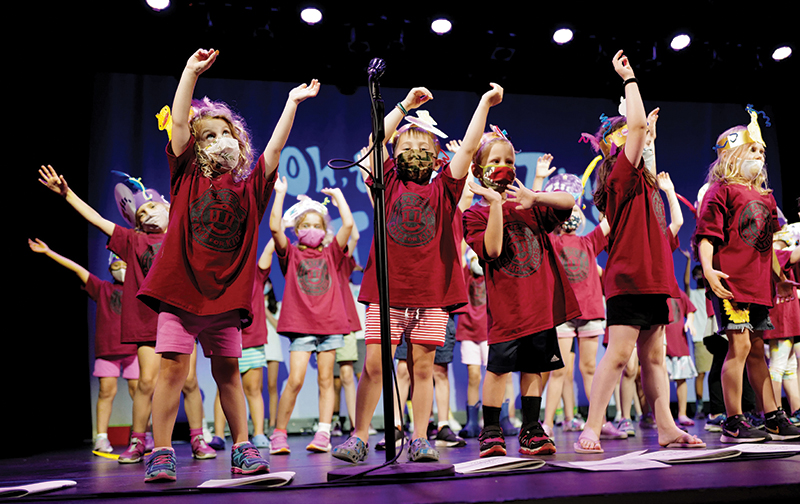
Kate’s Camp, Oh The Thinks You Can Think.
Image Credit: Stephen Fritzer
During the year following the pandemic, performances shot back up to an incredible 266, while Kate’s Camp for Kids returned to six week-long intensive performing arts camps for children ages 5 to 10, as well as two Summer Spotlights for ages 11 to 13. “We have a lot of different irons in the fire,” says Andreoli. “And we make sure both the audience and the artist experiences are top notch. That’s why we see some big artists come back over and over.”
A quality experience is also offered to the 4 full time staff, 34 rotating part-time technicians and bartenders, and 200 volunteers. Vicki Sullivan has been volunteering as an usher for The Kate for 13 years. “This is the best little theater around here. Everyone is fabulous; everything about it is wonderful,” she says. “The range of programming has taken off, with twice as many shows as we used to have when we first opened.” She drives in from Clinton to show after show, one of many from near and far to have fallen in love with the theater.
The statistics on that are startling: 10% of the audience is from Old Saybrook itself, while 48% make the drive from a region sweeping from New London to Middletown to New Haven. Another 33% comes from the rest of Connecticut, while another 9% come from out of state. “Half our radius is water,” says Elliot. “But it’s a great place to be.”
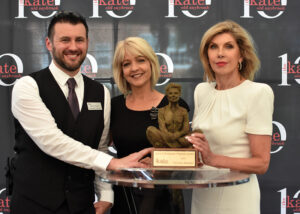
Spirit of Katharine Hepburn Award presented to Christine Baranski.
Image Credit: Stephen Fritzer
A membership program helps build that close connection. “People who become members feel like this is their comfortable place,” says Andreoli. “They feel safe, the community is extremely welcoming, they have favorite seats.” Priscilla Martel, a food writer and member at The Kate, agrees. “You get intimate with the performers in a little theater like this,” she says. “I’ve been coming since the beginning 13 years ago.”
The renovated museum is certainly helping to bring more attention to the theater; only two months after it opened, it already tallied 2,000 visitors unrelated to the shows. One of the highlights is the collection of letters from Hepburn to her family during her early days as an actress, given by the Ellsworth and Marion Grant estate. “It was amazing to read Kate’s own words,” says Andreoli. “And with the expanded museum, we can explore her life and her family history, like her mother’s experience as a suffragette. It’s bringing people to The Kate for the first time who get interested in the shows, and vice versa.”
“After all,” she continues. “How many small theaters have Kate’s name and a museum? We serve a community that she loved.”
Indeed, Hepburn lived at the mouth of the Connecticut River in Fenwick for nearly her entire life, getting out of the hustle and bustle of Los Angeles and back to a place where she could be just Kate. She visited the building that became The Kate a few times, since she spent a lifetime down the road. Although she passed away before the theater was renovated in 2009, the estate agreed to the name. The branding color is red because it was her favorite color. “There’s a lot of Kate here,” says Elliott. “Her spirit.”
Between the television show and virtual programming, this small cultural arts center has connected with collectors and fans of Hepburn around the world. They are continuing to build a global audience with the new Kate Enthusiasts program. One of the recent virtual programs was a “collection share,” where collectors could show mementos and memorabilia that they owned to other collectors via Zoom. Fans don’t have to live nearby for that; the furthest Kate enthusiast so far lives in Thailand. “We want to be the resource for all things Kate,” says Elliott. “If we don’t have it, we will know where to send you.”

The museum.
Image Credit: Brett Elliott.
This small theater has found ways to survive and even thrive during the pandemic. They have started partnering with New London’s Garde Arts Center for larger events and have become a respected venue for major artists from around the world who are booking their tours. And the future looks bright. “I see continued evolution,” says Elliott. “I think we don’t want to be any one thing forever. Besides, there’s still a lot to be learned from Kate.”
That evening we take our seats while Loudon Wainwright III walks onto the stage to a chorus of clapping and hooting. He strums the guitar and launches into his witty and touching songs, transforming his personal pain into jokes and riffs. The hours speed by as we absorb the words and music and feeling, the culture he is creating as he plays. “What gets done is what counts!” he sings while plucking a banjo. “Nice to be back here at The Kate!” he closes out the show.
Afterwards, an undeniable spirit hangs in space above the stage, floating through the museum lobby and filtering out the door as we file into the foggy night. We take it with us to homes near and far, passing it on to others we meet. In that way, spirit to spirit, each to each, culture forms. And that creation begins hundreds of nights a year at The Kate.

